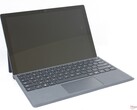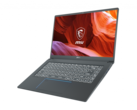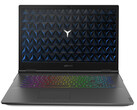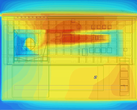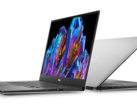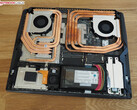Comparing the performance of various laptops can be difficult for prospective laptop buyers. Many people looking for laptops often shop by parts and specs, but the answer isn’t exactly as simple as a number or a component. Laptops with the same CPUs and GPUs can perform wildly different from each other due to thermal design. Thermals are a very important consideration for anyone looking to do any sustained, intensive tasks such as gaming or rendering video.
In our laptop reviews, there are often stress tests of the laptop in question. Often, the laptop will have been tested with Prime95 and FurMark (you can check our testing criteria here for more info). These tools put the system under maximum load and put the laptop’s thermals to the test, heating up the laptop’s CPU and, if it has one, dedicated GPU. The heatsink (with the assistance of thermal compound) wicks away that heat and carries it to a stack of fins in front of a fan. Then, the fan pushes air across those metal fins, cooling the fins and the heatsink. The chips in your computer, the thermal paste, the heatsink’s materials and design, and the fans all play into how well a certain laptop cools.
Ideally, a laptop will be able to maintain reasonable temperatures, power levels, and clock speeds at the same time. Often, laptops will throttle down rather significantly under stress test conditions, which isn’t ideal for long gaming sessions or video render times. Additionally, not keeping the laptop’s components cool could potentially shorten their lifespan. This isn't even considering the reduction in fan noise an "excessive" thermal solution could provide.
An important thing to note is that if your ideal laptop doesn't include a GPU, looking at results under CPU-only load should be good enough as the integrated GPU is part of the CPU and likely won't noticeably affect performance. However, if a combined test is provided, it wouldn't hurt to look at it and make sure there isn't any strange behavior when the integrated GPU is under load. Ryzen APUs (such as the AMD Ryzen 5 3500U) will sometimes exhibit different performance behavior when under combined load, so it's worth looking at. Additionally, certain CPU loads (like Prime95) are better at generating heat than simulating the clock speeds you'd be achieving in games.
For a good example, take a look at our review of the Lenovo Legion Y740-15ICH (i7-8750H, RTX 2070 Max-Q). Otherwise, just about any laptop review will work.
The first factor in determining a laptop’s thermal performance is the wattage the system is running at. The CPU Package wattage is the amount of power your CPU is consuming. This number also corresponds to the amount of heat the CPU is putting into the heatsink at any given moment, as well as the relative performance level the CPU should be at. This number can be read via HWInfo64 for Intel CPUs but has to be read through special tools for AMD's Ryzen chips as of right now. AMD has a special performance profiling tool that can be used to monitor this.
The second factor is the average core temperature. If you can’t see the average core temperature, then you can consider the CPU package temperature, or even the temperature of a single core. Your conclusion will be less accurate, but you’ll have a general idea of what you’re getting into. If you have all the core temperatures and the averages for them, add them all together and divide them by the core count. Now you’ll have an average overall core temp. If that number is less than 90, then the system is maintaining a temperature that would be considered safe.
Now, it’s time to consider both. For both Intel and AMD, you should look for machines that can sustain wattages at or above TDP, or Thermal Design Power. Often, CPUs can (and often will) demand more power than Intel’s listed TDP, so don’t be surprised if you find a CPU is drawing more than its listed TDP (here's an example: the Intel i7-8550U specification page). If this CPU has a cTDP (listed on AMD’s product page for the CPU, here's an example of that) or a TDP-up (for some Intel CPUs), look for a laptop that can maintain the maximum listed wattage while remaining below 90 °C. Ultimately, more wattage at reasonable temperatures is better than less when comparing between the same processor family.
If you’re comparing between different processors, it’s important to keep in mind that not every processor is going to “scale” the same way as another when it comes to performance by wattage. Older Intel chips using, for instance, a CPU with a bigger nanometer process will require more watts for much less performance than a 14nm chip at that same wattage. It’s important to keep thermal performance in mind, but actual performance at those wattages will differ between nanometer processes and manufacturers.
When looking at gaming laptops, it's very important to look at the sustained and combined stress tests (both a CPU and GPU load, such as Prime95 and FurMark, respectively). As a general rule of thumb: The longer the stress test period, the better the data. Something around 10 to 15 minutes should be more than enough on most laptops to find any sort of thermal problems. The importance of stressing both the CPU and GPU (rather than simply running a game as a load) is that it provides a repeatable test for all laptops. Running games (not game benchmarks) as a load can be unpredictable when it comes to thermals, as not all situations in games will put your hardware under repeatable loads.
For validating GPU performance in stress test conditions, check the chip manufacturer's product page (such as NVIDIA, AMD, and eventually Intel for their future dedicated GPUs), or one of our graphics card info pages (such as this one for the NVIDIA GeForce RTX 2070 Max-Q) for the TDP. Some GPUs can be set at various power limits. For the RTX 2070 Max-Q, power limits have spanned from 80w to 115w depending on the laptop, so it's important to check and make sure it's running at a known TDP under stress conditions. Additionally, a way to verify the configured TDP of the GPU is to simply run a stress test (or view a stress test ran on it) and check the maximum and average wattage. Your average should be around a known TDP, with a maximum above the average by a fair amount (say 10 to 20 watts under certain conditions).
It's important to note that stress tests aren't going to be applicable to everyone's desired workloads now but could later. If you plan on buying a laptop to keep for a few years, making sure you get one with great thermal performance now will only benefit you later. Lower temperatures over a laptop's lifespan can help increase the longevity of the thermal compound, as well as allow the components to work harder in the future when software grows more demanding. This is especially important in a gaming laptop as games grow increasingly demanding all the time. Recent AAA games, such as EA's Battlefield V, are already pushing laptops hard, and this isn't going to stop any time soon.
Overall, the best bargain laptops, at least when it comes to performance, are the ones that can handle high wattages for long periods of time while maintaining respectable temperatures. There are always other important factors in a purchase decision like weight or styling, but if performance is at the top of your list, now you know how to make sure you're getting it.





